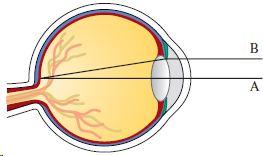Light enters the eye through the pupil and strikes the retina, where photo receptor cells sense light
Question:
Light enters the eye through the pupil and strikes the retina, where photo receptor cells sense light and color. W. Stanley Stiles and B. H. Crawford studied the phenomenon in which measured brightness decreases as light enters farther from the center of the pupil. (See the figure.) A light beam A that enters through the center of the pupil measures brighter than a beam B entering near the edge of the pupil.
A light beam A that enters through the center of the pupil measures brighter than a beam B entering near the edge of the pupil.
They detailed their findings of this phenomenon, known as the Stiles–Crawford effect of the first kind, in an important paper published in 1933. In particular, they observed that the amount of luminance sensed was not proportional to the area of the pupil as they expected. The percentage P of the total luminance entering a pupil of radius r mm that is sensed at the retina can be described by
where p is an experimentally determined constant, typically about 0.05.
(a) What is the percentage of luminance sensed by a pupil of radius 3 mm? Use P = 0.05.
(b) Compute the percentage of luminance sensed by a pupil of radius 2 mm. Does it make sense that it is larger than the answer to part (a)?
(c) Compute lim r→ 0+ P. Is the result what you would expect? Is this result physically possible?
Step by Step Answer:






